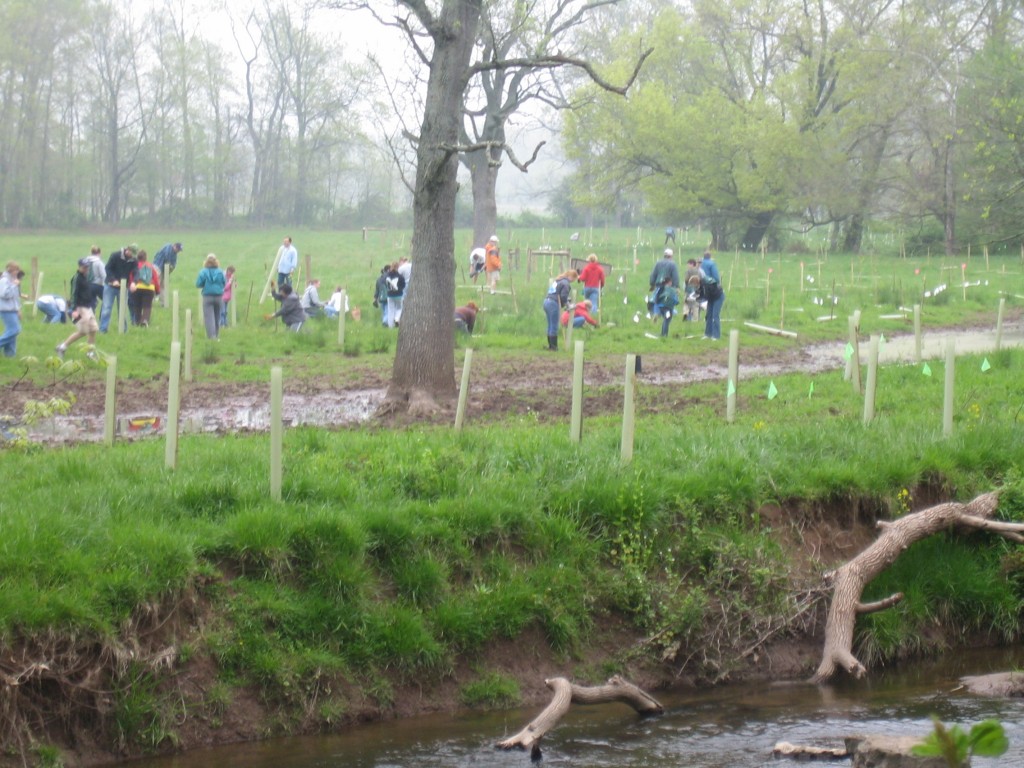
A riparian buffer is a vegetated area alongside a stream. A buffer can consist of trees, shrubs, or grasses. It is best if the buffer is composed of native plants. While a permanent forested buffer is the optimal approach, even tall grasses are better for stream health than no buffer at all. Riparian buffers are considered one of the best ways to improve the health of a stream.
The Benefits of Buffers
Riparian buffers are natural streamside water filters for rainwater flowing over land surrounding a stream. The vegetation along the stream reduces runoff of sediment and pollutants from the land and increases nutrient uptake so that excessive nutrients such as nitrogen or phosphorus are less likely to pollute the water. The wider the buffer area, the more efficient it will be in protecting the stream. A stream with a buffer will process nutrients and pollutants faster than a stream without a buffer, with forested buffers outperforming grass buffers.
Riparian buffers also stabilize stream banks to reduce erosion. Matured trees can help shade the stream, cooling water temperatures making the stream healthier for fish.
Where livestock have access to the stream, a riparian buffer coupled with stream bank fencing is the best approach. Livestock directly contribute nitrogen and phosphorus to the stream as well as bacteria and other pathogens. Not only does restricting cattle access improve water quality, but it is also safer for the cattle and improves herd health.
Maintenance
After planting shrubs and trees to create a riparian buffer, it is very important to perform regular maintenance. Maintenance includes mowing, herbicide application, and restaking and removing tree tubes. Without this minimal maintenance it is very likely the trees will not survive to create a healthy riparian buffer.
Streamside Forest Buffers Preserving Water Quality
Conewago Creek Watershed Restoration Explained, Matt Royer
Programs
Conservation Reserve Enhancement Program (CREP)
CREP is a voluntary program that rewards landowners for installing conservation practices, like buffers, on their land. CREP offers up to 100% cost reimbursement for installation, annual rental payments, and cash incentives. Find more information on the CREP website: http://www.creppa.org/
Conewago Watershed “Buffer Bonus” Programs
Farmers in the Dauphin and Lebanon County portion of the watershed who install forest buffers can earn a credit of $3,000 per acre to put toward the costs of installing other agricultural BMPs on their farms. Plain Sect farmers are also eligible to work with the Chesapeake Bay Foundation on a similar program.
NRCS Programs
NRCS funds riparian buffer establishment through their conservation cost share programs for eligible farmers. Grass buffers may be funded through these programs.
TCCCA Fall Buffer Planting Program
Each year, TCCCA maintains a small native nursery (around 200 trees and shrubs), and plants them in the watershed in the fall. If you have a small area of stream, this program may be for you.
Resources
Chesapeake Bay Foundation’s CREP Buffer Maintenance Guide:
“Landowner Guide to Buffer Success: A Comprehensive Seasonal Guide for Your Forested Buffer Project”
Summary Guide from the Tri-County Conewago Creek Association
USDA FSA
Webinars & Presentations
Water Quality & Stream Protection
Contacts
Ashley Spotts
In-Field Stream Buffer Specialist
Pa Chesapeake Bay Foundation
717-234-5550
Stephanie Eisenbise
Tri-County Conewago Creek Association
717-234-5550
